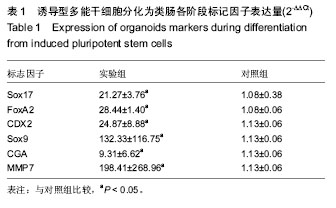中国组织工程研究 ›› 2017, Vol. 21 ›› Issue (25): 4057-4061.doi: 10.3969/j.issn.2095-4344.2017.25.020
• 干细胞培养与分化 stem cell culture and differentiation • 上一篇 下一篇
诱导型多能干细胞在体外三维环境中诱导分化出肠道类器官
李向阳1,赵 鑫1,相小松1,郑 鹏1,惠 璜2,嵇 武1
- 1南京大学医学院附属金陵医院,解放军南京军区南京总医院解放军普通外科研究所,江苏省南京市 210002;2解放军第二军医大学,上海市 200433
Induced pluripotent stem cells differentiate into intestinal organoids in three-dimensional niche in vitro
Li Xiang-yang1, Zhao Xin1, Xiang Xiao-song1, Zheng Peng1, Hui Huang2, Ji Wu1
- 1Jinling Hospital, Medical School of Nanjing University, PLA Research Institute of General Surgery, Nanjing General Hospital of Nanjing Military Region, Nanjing 210002, Jiangsu Province, China; 2Second Military Medical University of PLA, Shanghai 200433, China
摘要:
文章快速阅读:
.jpg)
文题释义: 肠道类器官:肠道类器官是衍生于多能干细胞或肠道前体祖细胞,在细胞成分、特定功能和组织结构等方面与相应的器官高度相似,包含肠道隐窝结构及构成隐窝的干细胞、潘斯细胞、杯状细胞和内分泌细胞等。
摘要
背景:诱导型多能干细胞是一类特殊的细胞,具有自我更新及多向分化潜力,在一定诱导条件下能够分化为肠道类器官。
目的:探究诱导型多能干细胞在体外特定条件下是否可分化出肠道类器官。
方法:复苏B6J小鼠18代诱导型多能干细胞,培养3 d克隆单位覆盖培养皿80%左右后,加入含有激活素A的培养基培养3 d,得到确定性内胚层,加入含成纤维细胞生长因子4和Wnt3A的培养基培养4 d,得到中后肠细胞球,将其与Matrigel培养基混合后滴入四孔板形成滴株样生长,在HEPES、Rspondin1、头蛋白、表皮细胞生长因子、B27添加剂等生长因子等共同作用下向肠道类器官分化,期间观察细胞形态变化,检测确定性内胚层FoxA2、Sox17表达,中后肠细胞球特异性标记物CDX2表达,肠道类器官特异性标记物 Sox9、CGA、MMP7表达。
结果与结论:①诱导型多能干细胞在含有激活素 A的培养基培养3 d,细胞初步分化,相互融合,确定性内胚层标记物FoxA2、Sox17表达较诱导型多能干细胞明显升高(P < 0.05);②确定性内胚层在含成纤维细胞生长因子4和WNT3A环境下培养第3天开始就有少量中后肠细胞球形成,第4天大量中后肠细胞球形成,中后肠细胞球标记物CDX2较确定性内胚层明显升高(P < 0.05);③中后肠细胞球培养3 d后逐渐形成肠道类器官,其特异性标记物 Sox9、CGA、MMP7表达明显高于中后肠细胞球(P < 0.05);④结果表明,诱导型多能干细胞可在体外三维环境中诱导分化出类肠道器官。
中国组织工程研究杂志出版内容重点:干细胞;骨髓干细胞;造血干细胞;脂肪干细胞;肿瘤干细胞;胚胎干细胞;脐带脐血干细胞;干细胞诱导;干细胞分化;组织工程
ORCID: 0000-0002-6058-2888(嵇武)
中图分类号:


.jpg)
.jpg)
.jpg)
.jpg)